In the meantime, for up-to-date analyses on the state
of the world, I invite you to visit the website linked below. The Diaries
of Miss Arieff, American "expooptriate" extraordinaire, cannot
be equalled.
http://www.rachelarieff.com/
In 1995 when the Internet was very young, I was hired
to write a column for "FilmZone" an early movie website (voted
the Best Movie Website of 1995 by Entertainment Weekly magazine). Here
are some of my articles:
"100 YEARS OF RELIX"
As 1995 fades into history, the year will be remembered as the official
100th anniversary of the first public presentation of motion pictures.
To be precise, it was on December 28, 1895 that the first projected
motion pictures were displayed to a paying audience -- at the Grand
Café in Paris. The Academy of Motion Pictures Arts & Sciences
recently honored the event by recreating the Paris café at its
Beverly Hills headquarters -- and presenting the original films shown
100 years ago. The American Film Institute will create a new attraction
at Florida's Walt Disney World commemorating 100 years of American filmmaking.
In Britain, the celebrations will begin next March with Cinema 100.
Ironically, 1995 is also the year in which the NEA ceased funding for
the preservation of our U.S. film heritage, which amounts to a shortfall
of $700,000 per annum. The U.S. Government says the studios themselves
must save their own films and not rely on public funding. At the same
time, the British Film Institute has also experienced the loss of grants.
Fortunately, the studios are taking more and more responsibility for
preserving their heritage, plunging into their vaults to discover and
restore lost treasures and then releasing them to the public via videotape
and laser disc.
Turner Entertainment Company, which owns the rights to the entire
MGM library, the pre-1950 Warner Bros. films and the entire RKO Radio
Pictures library has been restoring its films since 1986 (not to mention
colorizing a lot of them). Sony, with a 3,000 film library, has created
partnerships with film archives and have already restored "Lawrence
of Arabia", "On the Waterfront", "The Wild One"
and Capra's 1931 "The Miracle Woman." Columbia Tri-Star launched
a line of restored classics with its Studio Heritage Collection. Paramount
has built storage and restoration facilities for its 800-plus film library,
most post-1948. Warner Bros. has several thousand films (post-1950)
for which they have built a high-security refrigerated building to archive
their films; restoration projects are under way.
Studios are creating liaisons with archivists at UCLA, the Museum of
Modern Art in New York, the George Eastman House in Rochester, New York
and the Library of Congress in Washington, D.C. And many video distributors,
such as Kit Parker Films, Kino Video, Video Yesteryear and even the
Smithsonian Institute are releasing lost classics. Never before have
so many "relix" become available for the general viewing public.
In 1990, Martin Scorsese along with Spielberg, Lucas, Coppola, Redford,
Woody Allen, Stanley Kubrick and Sydney Pollack formed the Film Foundation
dedicated to film preservation -- just in time, too, because it has
been discovered that not only are the ancient silent films and early
talkies in need of saving, but such comparatively recent films as "Star
Wars", "Taxi Driver" "The Last Picture Show"
and "Easy Rider" are also fading away.
It has long been known that nitrate film (used up to 1950) deteriorates
alarmingly; restoration during the past 20 years has involved transferring
the negative to acetate stock, however, it is now apparent that this
"safety" film also decomposes much more quickly than expected.
New digital technologies are the answer, as Disney's brilliant 1993
restoration of "Snow White and the Seven Dwarves" proved.
Other recent examples include "My Fair Lady" [at a cost of
$600,000], "Doctor Zhivago," Buñuel's "Belle de
Jour" and Renoir's "The Golden Coach." "RELIX"
will keep you abreast of the latest restoration projects as well as
information on new technologies, funding issues and film festivals (such
as cable's AMC Film Preservation Festivals and Italy's Pordenone Festival).
"RELIX" will also provide information regarding the newest
discovery of lost films. For example, last year the Australian National
Film and Sound Archive donated more than 1,600 lost U.S. films, many
dating from before 1900. A few years ago, the Dutch Filmmuseum discovered
early Disney "Alice in Cartoonland" shorts (combining live
action and animation) from the early 1920s thought to have been lost
forever. In 1988, perhaps the first feature film, made in 1896 by French
pioneer Georges Méliès, was rescued and restored by the
New Zealand Film Archive. The British Film Institute launched a "Missing
Believed Lost" campaign in 1993 and new discoveries are turning
up all the time.
"RELIX" will also provide reviews of the newly restored
classics as they are released on video and laser disc and on whatever
new technologies that are sure to evolve. We are truly living during
exciting times, when the past really does come alive.
Craig David Calman
December 1995
"FORBIDDEN HOLLYWOOD"
Craig David Calman
There is a series of old Relix available on videocassette presented
by MGM/UA Home Video and Turner Home Entertainment called "Forbidden
Hollywood." These films, hosted by Leonard Maltin, include a number
of the risque, racy and scintillating movies turned out by Hollywood
from the beginning of the talkies until the moral watchdogs of the nation
imposed censorship restrictions (known as the Hays Code) in 1934 to
make sure that the rough and dangerous edges of sex, corruption and
moral turpitude flooding the screens during that Prohibition era were
smoothed away to present a more cheery, palatable, never-never land
of wholesome entertainment which is what Hollywood is remembered for
during its subsequent "Golden Age."
Ideally, the "Forbidden Hollywood" series should have been
hosted by a rough edged personality like Jack Nicholson, who would have
felt instantly at home in the cynical wisecracking world of the early
'30s. As it is, it's somewhat hard to take a soft and fuzzy PG-13 guy
like Leonard Maltin completely seriously when he talks about these sexy
no-holds-barred films. But then again, maybe that's part of this series'
charm.
Nevertheless, to devoted Relix lovers, "Forbidden Hollywood"
offers lots of fascinating viewing. The definitive examples of these
films came from Warner Bros.; they have a snappy style, a crackle and
they move with a pace that never lets up. The often complex stories
are told in record time -- quite a few of these films run just a little
over an hour. It's enough.
This was the era when such consummate stars as James Cagney, Joan
Blondell, Edward G. Robinson, Bette Davis, Barbara Stanwyck and Clark
Gable first burst onto the scene to blaze forever in the Hollywood firmament
(as they used to say). And there were also plenty of talented stars
who are unjustly forgotten today, such as Warren William, Ann Dvorak
and May Robson -- actors who really knew how to act. And what great
character actors! With talents like Ruth Donnelly, Allen Jenkins, Una
Merkel and Lewis Stone lighting up the screen, there was literally never
a dull moment. The talented screenwriters included Anita Loos, John
Monk Saunders and Preston Sturges before he became a director.
Over at MGM the movies were a little more refined, starring Lionel
and John Barrymore, Greta Garbo and Norma Shearer, but that studio also
churned out some real hard-edged gems. And in 1932 MGM signed Jean Harlow,
perhaps the sexiest floozy of all time. Paramount had Marlene Dietrich
who engaged in plenty of sophisticated whoring and enjoyed parading
around in male drag, and of course, Mae West, whose shameless obsessions
over sexual pleasures became the catalyst responsible for the implementation
of the Hays Code as an "antidote to screen amorality," especially
after Night After Night (1932), She Done Him Wrong (1933) and I'm No
Angel (1933).
Petty larceny, promiscuity, drug addiction and chicanery of all sorts
-- anything to make a buck -- these were the themes of Pre-Code Hollywood.
It alarmed the moralists, the lawmakers and orthodox religious organizations,
and these salacious matters were formally put under wraps in Hollywood
in 1934, a code of censorship not to be lifted by the U.S. movie industry
for some three decades.
Titles to check out, after you've seen the more famous films of the
era like Public Enemy, Little Caesar, Scarface and All Quiet On the
Western Front include: Night Nurse (1931) starring Barbara Stanwyck
as a girl desperate for a job during the Depression, a decent kid in
a tough world, with a pal like Joan Blondell to show her the ropes in
the treacherous world of the medical profession. James Cagney's series
of films after he became a star in "Public Enemy" are great
fun and include such jewels as Blonde Crazy (1931), Taxi! (1932) Picture
Snatcher (1932) and Hard To Handle (1933).
If you get off on the tango of ruthless big business dealings, nothing
will give you greater pleasure than viewing the supremely self-confident
Warren William as an egomaniacal master architect in Skyscraper Souls
(1932) and as a despotic department store executive in Employees' Entrance
(1933). After watching Mr. William in action, one may not be way off
the mark in considering his characters as role models for certain heartless
politicians and high rolling tycoons who exist to this day (and who
shall remain nameless).
You want sexy? Check out Red-Headed Woman (1932). An unscrupulous
low-class bimbo of a secretary has but one goal: to seduce the handsome,
upright young boss (married, of course) and then to climb to the top
of the social ladder (and she doesn't care if her panties show in the
process) with his father's elderly business rival. Jean Harlow is superb
and so is the entire cast in this witty, delightful movie. Ms. Harlow
plays another tramp in Red Dust (1932) set in the steamy jungles of
a rubber plantation, with Clark Gable and Mary Astor rounding out the
eternal triangle. This is one geometrical-lustful configuration that
really sizzles!
TO BE CONTINUED
"FORBIDDEN HOLLYWOOD"
PART II
Not a small part of the fascination of watching old films is having
the opportunity to see favorite performers in unexpected roles, to discover
new (old) talents for the first time and to follow the careers of long
lived veterans. From the perspective of 60 years later, the "Forbidden
Hollywood" video series provides ample experiences of this type.
Ever hear of Ann Dvorak? All you have to do is see The Strange Love
of Molly Louvain (1932) and Three on a Match (1932) and you'll be in
awe. A beautiful woman with a honey warm voice, she is a tragedienne
who could as easily have played Shakespearean roles as appear in these
tawdry tales of big city vice. She brings a quality of heartbreak which
is rare. At her peak in the '30s, Ann Dvorak's career seems to have
ended in 1951; she died in 1979.
Ruth Donnelly has to be one of the funniest character actresses ever,
especially in Hard to Handle (1933) and Footlight Parade (1933). She
often played overworked secretaries trying to stay sane under the punishing
demands of her lunatic bosses, most notably in Blessed Event (1932).
Lee Tracy plays her boss in that one: of all the obnoxious sleaze bag
newspaper reporters ever to have appeared on the silver screen, his
must take the prize.
Lee Tracy's vocal delivery can be described as nasally adenoidal and
he plays an egomaniacal, manic machine-gun mouthed weasel -- which is
typical of most of his roles. Incredibly, Mr. Tracy starred in a number
of films in this era: at his most revolting (if that is possible) in
Bombshell (1933) starring Jean Harlow, a movie called "the wittiest
satire on Hollywood" by one reputable critic and given ***½
by Leonard Maltin; but Mr. Tracy's character is so unlikable, so irritating,
so despicable, I wouldn't be surprised if you were ready to throw rotten
anchovies at your TV screen whenever he appears.
Richard Barthelmess was a beautiful young male star of silent films.
He first appeared on the screen in 1916 and quickly rose to the top.
His career flourished throughout the '20s and he made the transition
to talkies with ease. Though he no longer retained the youthful image
that made him a star, and possessed of a strangely lugubrious way about
him, Barthelmess appeared in several of the most fascinating movies
of the early talkie period: The Dawn Patrol (1930), The Last Flight
(1931), Heroes For Sale (1933) and Massacre (1934). These were serious
films with serious themes and he was one of the highest paid actors
in Hollywood at that time, earning $8,500 a week.
Walter Huston was the father of director John Huston. He went from
Broadway directly to Hollywood and the talkies made him a star. He was
the villain in the classic western The Virginian (1929) and he played
Abraham Lincoln (1930) in D.W. Griffith's film. Three years later he
played another U.S. President (fictional) in Gabriel Over the White
House. It is fascinating to see during this Election year: a crooked
politician who becomes President and then (via the supernatural inspiration
of the angel Gabriel?) becomes morally transformed. The problems of
the Depression are quite vividly expressed in this film, and so are
other social ills of the early '30s in other Walter Huston films such
as The Criminal Code, The Beast of the City, The Wet Parade, Night Court
and American Madness. Walter Huston was without a doubt one of the finest
actors to appear on the screen. His career remained strong right up
until his unexpected death (at a vigorous 66) in 1950.
Lewis Stone was also a fine, mature actor, though unlike Walter Huston,
he was almost always "in support." Though occasionally given
co-starring roles, he was considered, along with Lionel Barrymore, "The
Grand Old Man of Character Actors" at MGM. His image was set in
the '20s: a dapper, sophisticated older gentleman of the highest social
rank; he was most often sugar daddy or embittered husband to a youthful
Greta Garbo. In 1929 when he was 50 he played older, so that for the
next quarter century of his film career he was always the mature Lewis
Stone. He was superb with dialogue and had an understated dry wit.
He is memorable as the facially scarred World War I veteran in Grand
Hotel (1932): "People coming, people going, but nothing ever happens..."
he cynically observes while spending endless idle hours in the lobby
of the great hotel where, of course, everything is happening -- though
usually behind closed doors.
In Bureau of Missing Persons (1933) he is the head of that police department.
Presenting a sweeping panorama of lost souls in the big city, this is
a film not to be missed, especially as it contains a spirited performance
by an incredibly youthful, slender and lovely Bette Davis. Mr. Stone
plays his part with a sense of compassion, strength of character and
understanding of human foibles that is most admirable.
Since Lewis Stone usually played noble gentlemen, efficient businessmen,
understanding fathers and sober level-headed judges (as he so memorably
portrayed in the Hardy family series), it is quite a surprise to see
him playing a coward, which he does with great sensitivity, in the otherwise
rather silly China Seas (1935). His character does redeem his reputation
before the picture fades, and that's a big consolation. Lewis Stone
continued to work at MGM until his death in 1953.
Then there is Ms. Ruth Chatterton, the original "Madame X."
Her figure was not exactly girlish and she looked every minute her 40
years when she starred in a series of early talkies, however, she was
voted "Finest Actress on the Screen" by readers of "Movie
Fan" magazine in 1931 and called a greater actress than Garbo by
more than one critic, though her career, like that of Richard Barthelmess,
had faded away by the end of the '30s. In Female (1933) she plays a
powerful owner of an automobile factory who selects her lovers from
amongst her vast corp of employees. "A long time ago I decided
to travel the same open road men travel, so I treat men exactly the
way they've always treated women," she declares, forty years before
Women's Lib. On one wall of her ultra-chic executive suite there is
the mounted head of a two-horned rhinoceros. A male, no doubt.
Craig David Calman
February 1996
"RELIX"
Dear Heart
Newly released on video from Warner Bros. is Dear Heart (1964) a simple,
sweet love story directed by Delbert Mann and starring Glenn Ford, Geraldine
Page and Angela Lansbury. Delbert Mann was the perfect director for
this tale about a middle aged spinster (Page) who at last finds true
love; his first feature film was also about an unlikely prospect in
the romance department -- Marty (1955), also set in New York City, an
ugly butcher's search for a girlfriend.
And who could more perfectly portray the "Dear Heart" of
the title than Geraldine Page? An actress in the truest sense of the
word, she was an artist able to completely transform herself into any
role she played -- and she played every type of character imaginable
throughout a long career.
A native of Missouri, Ms. Page gained fame Off Broadway in the early
'50s for such plays as "Summer and Smoke" and "Yerma"
and then "Midsummer" made her a star on Broadway. She was
immediately invited to Hollywood and co-starred in the Technicolor western
Hondo (1954) with John Wayne for which she was promptly nominated for
an Academy Award. Wayne told her he would star her in every other film
he made, however, it quickly became apparent to him that Ms. Page was
not simply a midwestern farm girl turned film star, but a serious New
York actress studying with the likes of Uta Hagen and willing to appear
in plays of questionable political affiliations (this being the McCarthy
era). Ms. Page was not invited back to Hollywood for seven years.
Summer and Smoke (1961) was her next film, a faithful adaptation of
the Tennessee Williams play; a tale of Eros smoldering within a Southern
spinster's bosom. Ms. Page was again nominated for an Academy Award.
Immediately thereafter came a second Tennessee William adaptation: Sweet
Bird of Youth (1962). Here is a classic example of an actor's transformation:
Ms. Page portrays Alexandra Del Lago, glamorous Hollywood movie star.
Boozing, smoking hash and alternately loving and bickering with her
disreputable road companion (Paul Newman), Ms. Page is unforgettable
and garnered yet another Academy Award nomination (she earned a total
of eight nominations and one win during her career).
Then it was back to being a spinster -- this time with a fixation
on her brother (the late Dean Martin) in the intriguing Toys in the
Attic (1963) from Lillian Hellman's play. This was another serious drama
of misguided love, with the heartbreaking ending showing poor Ms. Page
sobbing her heart out on the staircase of her childhood home.
Therefore it is a relief to find her in a film with as happy a resolution
as that in Dear Heart. Glenn Ford also plays very sensitively in this
film. There is the ambiguity and uncertainty poignantly expressed in
this budding love affair. However, it is often a noisy film, set in
a busy hotel with a lot of carousing conventioneers, and this may be
detracting; then there's the character of a blonde bimbo who sells greeting
cards in the lobby who should have been played by Marilyn Monroe (had
she lived) or at least Jane Mansfield, and it would have been nice if
the film were in color, but aside from these flaws, there are two delicate
performances by the leads and a fun appearance by Angela Lansbury playing
a character unlike any other she's done. And the film does leave one
with a smile on one's face -- and in one's heart.
Geraldine Page always touches me that way. Through her craft she was
able to convey the reality of subconscious longings, desires and regrets
lying just below the surface of everyday life, and she also had a great
sense of humor. She was able to tap into that well of passion and emotion
and spirituality and express these realities with her every movement
and inflection. With regards to passion, Geraldine Page was also able
to plumb the depths of human depravity -- in Whatever Happened to Aunt
Alice? (1969) she plays a murderess of fascinating psychological complexity.
In The Beguiled (1971) with Clint Eastwood, she plays a Civil War director
of an all girl's school with a massive sadistic streak. In Nasty Habits
(1977) she is a nun who schemes, lights up cigarettes and swears like
a corrupt Teamster. In The Pope of Greenwich Village (1984) she is a
chain smoking, boozing widow with a heart of burnished steel.
On the brighter side, she could be the dear little recluse whose greatest
joy is making Christmas cakes in Truman Capote's A Christmas Memory
(TV)(1966); a beautifully gowned, class-conscious dunce in The Happiest
Millionaire (1967); a daffy society lady in Pete 'n' Tillie (1972);
a pathetically fragile woman falling apart as her marriage fails in
Woody Allen's Interiors (1978); a wise and sophisticated novelist dying
of cancer in I'm Dancing As Fast As I Can (1982) and of course, the
tragic country lady who had been torn from her land and after pining
away in the big city escapes to see her homeland one more time in A
Trip To Bountiful (1985) for which she finally won an Academy Award.
In June of 1987 Geraldine Page was playing Madame Arcati, a spiritualist,
in Noel Coward's "Blithe Spirit" on Broadway when she suddenly
died between performances at the age of 63.
In the early '60s, author James Baldwin watched Geraldine Page rehearse
for the Broadway production of "Sweet Bird of Youth" and wrote
the following reflection: "Acting is (for me, anyway) one of the
most mysterious of all the arts -- mysterious because the instrument,
the actor himself, without changing at all, undergoes such inexplicable
transformations before one's eyes. I think that this sustained and steady
tension between the real and the make-believe is healthy for the soul;
it forces one to examine reality again....[Geraldine Page's acting]
is a small light brought into a vast darkness -- but a small light,
considering, especially, what everyone is searching for, may be quite
enough. As for the light which Gerry holds, may it burn long."
Via film and video, it will.
Craig David Calman
April 1, 1996
"RELIX"
It Started in '96
"When the hall was darkened last night a buzzing and roaring
were heard in the turret, and an unusually bright light fell upon the
screen. Then came into view two precious blonde young persons of the
variety stage in pink and blue dresses, doing the umbrella dance with
commendable celerity. Their motions were all clearly defined. When they
vanished, a view of an angry surf breaking over a sandy beach near a
stone pier amazed the spectators....
"So enthusiastic was the appreciation of the crowd long before
the extraordinary exhibition was finished that vociferous cheering was
heard. There were loud calls for Mr. Edison but he made no response."
Thus is chronicled in "The New York Times" the very first
public screening to a paying audience of motion pictures in the United
States, on April 23, 1896 at Koster & Bial's Music Hall in New York
City. It may be that Thomas Edison made no response to the cheering
throng because deep down he knew that he was not the individual solely
responsible for the invention of projected motion pictures -- dozens
of inventors and scientists in the U.S., England, France and Germany
had spent years perfecting the technology, including Thomas Armat, the
Brothers Skladanowsky, the Brothers Lumière and William Friese-Greene;
but Edison was the one who got most of the credit.
For fascinating (and sometimes boring) viewing of those first years
of motion pictures, Kino On Video has released a five volume series
of videocassettes entitled The Movies Begin. Over 120 early films from
1894 to 1914 are presented. Volume I is "The Great Train Robbery
and other Primary Works." Aside from Edwin S. Porter's landmark
1903 narrative film, most of this volume consists of everyday scenes
captured by the motion picture camera: a train ride through the Colorado
mountains (1903), a trip around Manhattan (1903), San Francisco after
the earthquake (1906), Moscow in winter (1908), etc. Also included is
a documentary on dogs working as cart pullers, sheep herders, etc. There's
a comic bit of a hugely fat woman in her boudoir entitled Airy Fairy
Lillian Tries on Her New Corset.
Volume II, "The European Pioneers," features 40 works from
the earliest filmmakers such as R.W. Paul, a scientific instrument maker
who made Britain's first film projector in 1896. He utilized stop motion
cinematography and ran film in reverse to show a collapsing wall right
itself up again. He also anticipated Buster Keaton by 23 years in his
1901 short The Country and the Cinematograph, showing a man watching
a movie screen in which the screen becomes part of his reality. R.W.
Paul also played with the screen's parameters, having a fight between
two men occur below the screen with the combatants' clothing flying
up from below. James A. Williamson's Stop, Thief! (1901) must be the
great-grandaddy of all chase films. Clever trick cinematography is especially
noteworthy in The Motorist (1906). George Albert Smith was another innovative
pioneer who utilized the close up long before it became a common aspect
of film vocabulary.
Volume III is "Experimentation and Discovery" and includes
delightful films from the Pathé Freres' Peeping Tom (1901) and
Aladdin and his Wonderful Lamp (1906), Edwin S. Porter's The Dream of
a Rarebit Fiend (1906) and the hilarious The Fatal Sneeze (1907); it
also contains lengthy and dreary scenes inside a biscuit factory and
the tedious, quite unglamorous work in a coal mine.
Volume IV is "The Magic of Méliès." George
Méliès was perhaps the greatest of the pioneer filmmakers.
Although he basically just set up the camera in one spot and filmed
with no editing, his innovation lay in the content presented on the
screen: fabulous fantasy and comedy beautifully executed via imaginative
costuming, set design, special effects such as dissolves, fade ins,
superimpositions, stop motion, precise choreography and well timed action.
George Méliès (1861-1938) started out as a cartoonist
and then stage magician: these skills are very evident in every film
he made (around 500, from 1896 to 1912). The Academy of Motion Pictures
Arts and Sciences has restored and presented a wonderful sample of his
work; there is also a documentary about the magical filmmaker in this
volume.
Volume V: "Comedy, Spectacle and New Horizons" includes
a number of intriguing entries, such as a 1908 sampling of French comedian
Max Linder (Charlie Chaplin's acknowledged inspiration), cartoonist
Windsor McCay drawing his famous Illustrated Pictures in 1911 (with
an uncredited John Bunny, a jolly, fat and ugly comedian who made a
popular series of one-reelers with the dour, scrawny and equally ugly
Flora Finch before his death in 1915); Nero and the Fall of Rome (1909)
with a cast of dozens strutting around in togas; and the very first
Keystone Cops film, Bangville Police (1913) with Mabel Normand. Also
to be viewed is The Making of An American Citizen by Alice Guy-Blaché
showing Ivan, a brutish Russian immigrant who treats his wife like an
animal but who is taught by Americans to treat her as an equal.
I mentioned Ms. Guy-Blaché in a recent article describing recent
video releases from the Smithsonian Institute, identifying her as one
of the very first women filmmakers, and I have been asked by curious
readers to tell more about her. With pleasure.
According to film historian Ephraim Katz, Ms. Guy-Blaché was
the first woman filmmaker. She was born in France in 1873 and directed
her first film in 1896, La Fée aux Choux, for the Gaumont Film
Company. In 1910 she moved to the United States and formed her own company,
Solax. She pulled out of independent production in 1917 and returned
to France. At the age of 80 she was granted the Legion of Honor by the
French government. As Ms. Guy-Blaché lived to be 95, she might
have seen 2001: A Space Odyssey. Imagine what this film pioneer of 1896
experienced throughout a lifetime of movies!
Following Ms. Guy-Blaché as a woman pioneer in filmmaking was
Lois Weber (1882-1939) who began directing for Universal in 1913 along
with her husband Phillips Smalley (1875-1939). Her last credit is listed
as White Heat (1934)(not to be confused with James Cagney's 1949 film
of the same title).
So in this year of 1996 we are celebrating four centennial milestones
in cinema: (1) the first motion pictures projected for a paying public
in the U.S.; (2) R.W. Paul's first movie projector for Great Britain;
(3) George Méliès begins his remarkable series of fantasy
films; and (4) the first woman filmmaker, Alice Guy-Blaché, begins
her career. Let's hope the second hundred years of movies bring at least
as many new innovations and imaginative filmmakers as the first hundred.
Craig David Calman
May 1, 1996
"RELICS"
Au Revoir, Claudette!
One of the most beloved of Hollywood's superstars passed away recently
at the age of 92, she of the apple cheeks and throaty voice, "clever,
witty and typically Parisian," as one critic described her, the
highest wage earner of the U.S. in 1940, a star from her first talkie
in 1929 to her last television performance almost 60 years later, French-born,
American-maid, Claudette Colbert.
Few actresses could handle dialogue so brilliantly and so effortlessly
as Ms. Claudette Colbert; she possessed a smooth blend of sophisticated
intelligence, a warm heart and a generosity of spirit. She was the embodiment
of elegance and good taste yet she was no prude: she loved a good time
and in her early roles she was often amoral (Manslaughter [1930]) if
not downright pagan (Sign of the Cross [1932]). She conveyed her wholesome
enjoyment of life with a smile, a twinkle in the eyes, a crinkle of
her cute little nose and a purr in her voice. In every performance one
can sense her thorough and unwavering self-confidence -- she was monumentally
fearless when confronted with the challenges and obstacles which dominated
her films. Yet Claudette Colbert could collapse into a torrent of tears
when heartbroken and she could yield, if not melt like pure country
farm butter, when kissed by a true love.
When Claudette Colbert first appeared on the screen in the 1920s she
looked the epitome of the roaring flapper. With her round baby face,
big brown eyes and short skirts tightly outlining her slinky, sexy body,
she could have been the human model for Betty Boop. It was her surprisingly
deep, melodious and mature voice that revealed her to be no "Boop
Oop A Doop" nitwit.
Her maturity was there from the very beginning in her first talkies
of 1929, The Hole in the Wall and The Lady Lies, filmed at the Paramount
Studios in New York while she was appearing on Broadway. She and her
co-stars Edward G. Robinson and Walter Huston were immediately swept
off to Hollywood, and the rest is history. Claudette Colbert then proved
to be a lovely singer as revealed in two very early musicals with Maurice
Chevalier, The Big Pond (1930) and The Smiling Lieutenant (1931) but
for some reason, that avenue was not pursued.
These rare early talkies are available from that fabulous video store
specializing in such rarities, Eddie Brandt's Saturday Matinee, located
in North Hollywood, California. Through special arrangement, Saturday
Matinee members (the lucky dogs!) can be "loaned" (when renting
other titles) videos of rarely seen movies that have not yet been released
to the general public.
In The Sign of the Cross, Cecil B. DeMille's 1932 epic of Nero's Rome,
Ms. Colbert slips perfectly into pagan Empress Poppaea and became world
famous for the scene in which she bathes in a pool of goat's milk. She
so impressed that DeMille cast her in the title role of Cleopatra (1934)
where she easily survived some rather scathing reviews (i.e., "She's
a cross between a lady of the evening and a rough soubrette in a country
melodrama" -- "Variety.") She took her revenge by winning
the Academy Award that same year as the unforgettable runaway heiress
in the supremely delightful and perennially popular It Happened One
Night.
Ms. Colbert's acting kept getting better and better and throughout
the '30s and into the '40s she was an astute judge of material, appearing
in a great many of the best movies of that fabulous era of moviemaking.
MCA Universal has released the Claudette Colbert Collection which includes
Sign of the Cross and Cleopatra as well as Bluebeard's Eighth Wife (1938)
co-starring Gary Cooper, and Midnight (1939) with Don Ameche, John Barrymore,
Mary Astor, etc. -- which may just be the most perfect Hollywood comedy
of the '30s, with a dazzling script, flawless direction and masterful
playing by all concerned.
Another 1939 gem (of a rougher polish) is It's A Wonderful World co-starring
James Stewart. It's a not-quite-mad enuf madcap caper directed by W.S.
Van Dyke II who was at his best with exotic melodramatic adventures
and intrigues. So Proudly We Hail! (1944) is also in the Colbert Collection,
a tribute to the American Red Cross nurses during World War II produced
and directed by Mark Sandrich. Shown on AMC all the time is The Palm
Beach Story (1942) which is sort of a spin-off of (the more perfect)
Midnight.
The visually impressive Drums Along the Mohawk is available from Key
Video. This pioneer epic was rousingly directed by John Ford and is
one of the great Technicolor features of 1939 (along with Gone With
the Wind, The Wizard of Oz and The Private Lives of Elizabeth and Essex).
"Drums" is full of pleasure -- and pain. It is worth seeing
for the scenery and cinematography alone, but it also contains the spirited
performances of Ms. Colbert, Henry Fonda and a masterpiece of character
acting displayed by Miss Edna May Oliver (she deserved an Oscar). "Drums"
is full of scenes of birth and death and struggle. However, it presents
a completely one-sided view of the Native American/White settler conflict.
(Guess which side -- not a single colonist dances with wolves.)
Social comedy was really Claudette's forte, although during her career
she had appeared in all sorts of movies, from stark crime melodramas
like The Hole in the Wall (1929) in which she played an ex-con kidnapper,
"problem" pictures like Private Worlds (1935) as a psychiatrist
in a mental hospital and war stories like the realistic Three Came Home
(1950) as an American prisoner of war confined with her small son to
a Japanese concentration camp, matching wits with Sessue Hayakawa.
Somewhere in the late '40s the glitter faded. (How could it go on
unabated? That would have defied the laws of physics, I suppose.) Ms.
Colbert moved to Europe and appeared in a couple of French films. She
returned to Hollywood in the mid '50s for Texas Lady, which, aside from
her elegant and low keyed performance, wasn't much of a movie; she then
returned to Broadway -- where she had first been discovered in the '20s
-- and made a resounding success there for a number of seasons.
Amazingly, Claudette Colbert was to appear in only one other movie:
Parrish (1961) available from Warner Bros. Home Video. She plays teenage
heart throb Troy Donahue's well bred and deeply caring mother. The setting
is a 1961 Connecticut tobacco farm and she is, as always, sensible,
worldly and ready for love. Her scenes with Karl Malden are especially
moving. Ms. Colbert appeared in no other movies although she lived for
another 35 years and one wonders why she was absent from the big screen,
as she often stated to the press that she wanted to work. Perhaps it
was because Claudette Colbert could never have followed the path of
other women super stars of the '30s and '40s who prolonged their careers
by appearing in horror films. Anyway, she was fabulously wealthy and
the type of role she played so well had become passé in the turbulent
'60s.
Ms. Colbert retired to Barbados where she remained remarkably robust
and beautiful. She returned to the Broadway stage several times in the
'70s and '80s and was always warmly welcomed. She appeared before the
cameras one last time for the television mini series, "The Two
Mrs. Grenvilles" in 1986. David Shipman (a great gentlemanly English
film historian who passed away this April, much too soon) wrote of the
83-year-old star's final acting turn: "Stylish, chic and ever youthful,
using all her 60 years' experience by cleverly underplaying, it was
a performance to make the armchair viewer want to stand up and cheer."
Perhaps more than any other star of her time, Claudette Colbert was
the healthiest: there were only two types of women she could never play:
out and out bitches and mad women. Among her sterling portrayals of
women at their best are the super efficient executive secretary in She
Married Her Boss (1935), the dedicated and gentle psychiatrist in Private
Worlds, the inspiring school teacher in Remember the Day (1940), the
ideal wife and mother in Since You Went Away (1944) and the fearless
newspaper publisher in Texas Lady (1955).
In all these films she exhibited remarkable strength of character,
implacable sense of right and wrong, brilliant diplomatic skills and
a deep concern for the under dog. She was, in the final analysis, an
unwavering defender of justice, and it is self evident through the long
decades that Claudette Colbert possessed all the qualities which would
have made her nothing less than a superb U.S. President.
Imagine her cute face up there on Mount Rushmore! If they ever plan
to put another physiognomy in stone alongside such American giants as
Washington, Jefferson, Lincoln and Teddy Roosevelt, I for one hereby
nominate Claudette Colbert! So what if she was born in France? She emigrated
to the U.S. at the age of six and from then on has confirmed that there
has not been another individual to so perfectly represent the great
ideals of the American dream, Golden Age style.
Au, revoir, Claudette! The world's 92 year love affair with you continues!
Craig David Calman
August 15, 1996
#^#^#^#^#^#^#^#^#^#^#^#^#^#^#^#^#^#^#^#^

With my Irish Setter pup Patches when we were both
young.
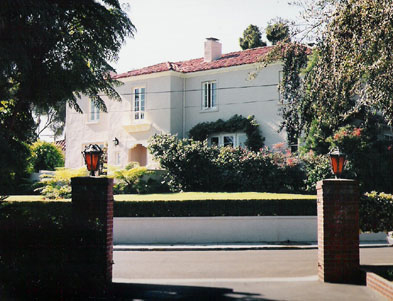
My magnificent home from age 12 through graduating
high school. Built in 1919 by Henry Lippitt (1886-1974) whose father
was U.S. Senator from Rhode Island and whose uncle and grandfather
were both Governors of Rhode Island in the 19th century. This home
was designed by famed architect William Templeton Johnston. I went
from riches to rags following what I call the American Hollowcaust.
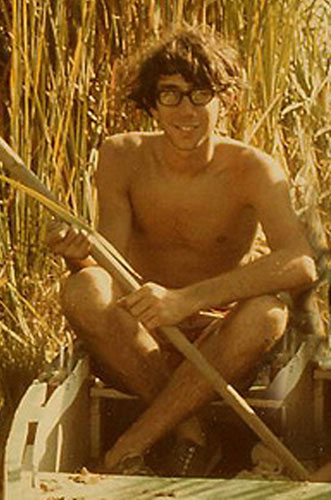
Huck Finn with glasses enjoying the pond in a summer
long ago.

Yearbook photo 1970

A wonderful gift given to me in 2004 by Jayne Moynihan
- an original oil painting by my childhood art teacher Loretta Metzger
McLeod (1913-1997) who held wonderful drawing and painting classes
at the Spanish Village, Balboa Park, San Diego where I went virtually
every Saturday from 1966 to 1971 and the summer of '72.
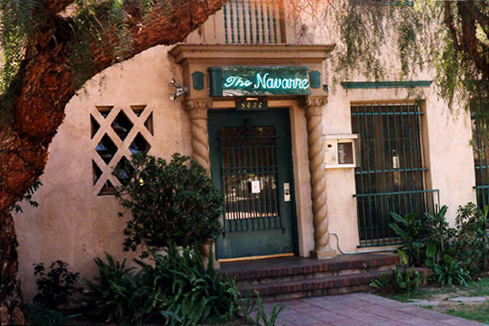
The 1925 Hollywood apt. rumored to have been built
by Ramon Novarro. My dear friend Don Higdon lived here from 1975 till
his death in 1993. I lived here when I arrived in Hollywood from the
late '80s to 1992. My neighbors in this building included Channing
Hanson, brother of the famous musician/singer Beck who would perform
at parties here as a shy teenager. I remember saying to him once,
"Beck, you're really talented. I'm sure you'll go far!"
Little did I know.
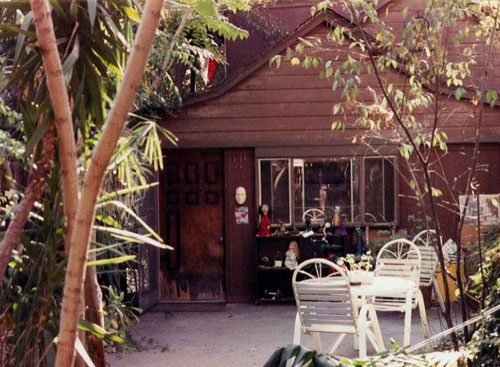
From 1992 to 1995 I lived at Birdhead Manor, quaintly
tucked away in the woods in North Hollywood and where I barely survived
the '94 Northridge Earthquake.

My next home in North Hollywood from early 1995 to
late 2000. My black cat Lunchbucket (1991-2003) is on the lawn. I
loved this home as I had lemon and fig trees outside my door and I
grew vegetables and planted numerous trees which within five years
were towering above the house. I also had a cool neighbor Rick Corrie
who lived in the guest house across the way.

Patches when he was 77 dog years and me, all growed
up yet a long time ago.
'80s MUSINGS, DITTIES AND CONTEMPLATIONS
BY YOURS TRULY:
"A DISARMING DITTY"
Is this aroma wafting before us from festering garbage or simmering
dish?
Is this bright painting hanging before us a new masterpiece or the
slop of a fish?
Is this cigar a supremo? Is this bonne fille 'de la creme?' Are these
macaronies extremo?
Go to the experts. Ask them.
Are these nice people drinking before us genteely tippling or thoroughly
pissed?
Are these sweet light notes soaring before us only for Muzak or worthy
of Liszt?
Dare we be seen in this sector? Will the Big Bomb blow us up? Should
I become a defector?
Only the experts 'fess up.
Is this assassin cringing before us mad as a hatter or fit for the
block?
Are these grand phrases flowing before us inspired from on high or
a lot of old crock?
Is this cigar a supremo? Is this bonne fille 'de la creme?' Are these
macaronies extremo?
Go to the experts. Ask them.
Is this old forest greening before us pristine and priceless or should
it be burned?
Is this old language languishing 'fore us ready for Babel or should
it be learned?
Dare we be seen in this sector? Will the Big Bomb blow us up? Should
I become a defector?
Only the experts are stumped.
Is this great leader leading before us the savior of nations or should
he be bumped?
Is this great doctrine doctring before us fair, just and holy and
will it be dumped?
Is this cigar a supremo? Should this old doctrine be dumped? Are
these macaronies extremo?
Only the experts are stumped.
-Written 1982
"A SALTY YARN"
Old Sonny gave the swabby a fiver and wished him good
luck and good sail. Then he strolled around the corner and stepped
on a rusty old nail.
"Me luck idn't wid me," he said with a groan.
"I gave it along with me fiver to Limey O'Keefe" he said
through his teefe as he pulled out the nail in short order.
So he hopped to the pub for a quick one, just something
to moisten his craw. As he downed his third creme de Burma he caught
a sight of old Ma.
"Ma Guzzle!" he cried with a song in his heart.
"I'm pleased as a peacock to see ya! Come sit by me side and
warm up me hide and tell me, how goes it my dee-ah?"
Ma Guzzle, she looked up at Sonny and gaped with a come-hither
leer. Cuz Ma Guzzle she hadn't seen Sonny in many-a many-a year:
Since that day he set sail on the salty sea brine, since
that day they began the great Battle of Rhine, Since that day all
were humming "The Carpet Sublime." (She hadn't seen Sonny
in ages of time.)
Ma Guzzle, to Sonny she sidled. She gave him a look
in the eyne. She gaped and she gawked as to him she walked, bringing
her bottle of wine.
"Sonny Me Boy," she said with a scowl, "I've
grown Rubenesque but I'm still on the prowl. I spend all me days here
in Pickle's Canteen till I've lost all me buttons and rotted me spleen.
Till me woolens is mothy and me 'air 'as gone green, till me one joy
in life is the backroom latrine. So Sonny Me Boy, it's just like a
dream to see you once more here in Pickle's Canteen."
"I stepped on a nail," said Sonny Me Boy.
"I stepped on a nail 'round the cornah. But that's over and done
-- it's time for some fun!" And he hugged her and kissed her
with lustah.
Now they've been together some 45 days; they've been
together the while. And they've laughed and they've sang and they've
danced to Coltrane and they've honeymooned twice up the Nile.
"THREE LADIES"
Amy O'Day was a stripper, a kitty from Avenuue B. Whenever
she strolled by the river, the tugboats would head out to sea.
Barbie McTeal was a blaster. She fixed broken walls
with her sand. In romance she truly was master, and she only charged
ten bucks a stand.
Christie Babu was a cooker. She worked at Pink Pup's
Bar And Grill. She whipped up a mean Stew de Oyster always served
with a happy time pill.
In love and work they were satisfied: these three ladies,
they never were blue. Only one thing remained to be gratified: each
craved a pretty tattoo.
So one night the three ladies united: Miss O'Day, McTeel
and Babu took a stroll, turned the corner and discovered Ye Mariners'
Parlor Tattoo.
On her thigh Miss O'Day put a cherry. On her ear Miss
McTeel put a fish. On her piggy-wig big Miss Babu put a fig; now each
has the tattoo she did wish.
"GOAT SONG"
She dressed her old goat in a doublet and flew him to
Port Au Dauphin. They drove to the Commissar's quarters and demanded
a thimble of jam.
The Commissar couldn't be bothered: he was busy with
strawberry pies. So they tied up his arms with some seaweed and escaped
in a clever disguise.
Now no one would know them from Adam for she purpled
her hair with a rinse and she twisted Goat's beard into ringlets and
no one has spotted them since.
But I know for a fact as I stand here today that the
lady is "extant" as sages would say. And Goat is still with
her, of that I am sure, for a little bird told me, a sparrow named
Myrrh.
Now Myrrh is a gossip, a ne'er-do-well. But Myrrh never
lies -- his soul's pure as a bell. Though once in a while (like quarter
to nine) he'll flitter and bramble and guzzle his wine.
And once in a while (when no one is looking) when hedgehogs
are hedging and cats are in twine, when cockatoos doodle and pineapples
pine, Mr. Myrrh will go winging from fence post to mine.
From Cedar Park Playground to Hickory Dole. From Sissyphus
Junction to Jupiter's Hole. From Appletown Manor to Hollywood Bowl.
From car lots to sand lots to hotplates and gall. From kippers and
herring to Rasputin's Mall. From rivers and slippers and apricot-stew,
from livers and drifters to call-out-the-crew, from snappers and rappers
and petticoat paint, from diapers and flippers to rain-on-my-gate.
And I know for a fact as grannys do dote, as bumble
bees bumble and gloat-fish do gloat, that the lady is "extant"
-- and so is her goat.
"SUBWAY ENCOUNTER I"
"Is it day or night?" the Black boy asked
through the vinyl of his hood.
"Is it day or night?" the scared boy asked
from the depths of the subway tombs
from the depths of his vinyl hood
from the depths of his quivering soul
from the depths of his mangled veins
"Is it day or night?" he asked.
"SUBWAY ENCOUNTER II"
Stern Black lady
Dressed all in black
Black dress, black coat,
Black sunglasses too.
Her face is stern, her jaw is set
No longer will she permit regret.
"SUBWAY ENCOUNTER III"
A daffy dame, no teeth no more
But that's okay -- "dentures are a bore!"
For garbage-sifting requires nothing more than good
eyesight and a prayer.
"SUBWAY ENCOUNTER IV"
What about that character staring at me from the window's
pane? A reflection of that guy -- it's a bit obscure.
He looks a bit tired 'round his prominent eyes. He looks
a little silly 'round his kindly little mouth. His hair is short right
now. He has no beard -- he shaves every day. Though he'd rather not,
I think.
He's always looking, always thinking thinking thinking
And dreaming.
He daydreams.
And remembers.
And imagines.
And dreams.
And yearns.
Always.
Oh -- and he wears the same kind of cheap blue vinyl
winter coat as does the scared Black boy who doesn't know whether
it's day or night.
Curious.
"The Last Summer Night On Ludlow
Street"
I see gargoyles as night descends
Velvet musk-blue
Their windows glow yellow and the chintzy bouncy curtain
spots do too
It's Manhattan's midsummer's eve
And a wall of Ice couldn't relieve the suffocated Latin
Wail
Here in Gargoyle Ghetto it's only in mind's I that I
see clearly what those old Puerto Ricans try to remember, what the
young Puerto Ricans have only seen as painted images on abandoned
walls --
corn
maize
beans
fields
burros on a river-cross
hacking trees -- it's a world I know and I'm off!
but here -- here!
rubble decay rust and shadows
the murder-flaming plume
the eagles glint darkly, stalking the nightly crawl
bottles puddles drunks brick
Gargoyle musk and velvet blue
The windows glow yellow and the chintzy bouncy curtain
spots do too.
-August 9, 1984
"1986 SUNSET"
As the sun sets over the American Empire we tremble.
Lost souls into the woods do ramble.
Weary peasants, loaded with pots, do trundle
In the distance, archangels grumble.
Bumblebees bumble, turnipseeds tumble
Even R. Reagan is starting to crumble
Lift up your knees, partings are humble.
Try me no more with that ham and his cronies. Bake 'em
for Christmas all smothered in honies.
Show me once more how the gypsies do gamble with life
everlasting, with gods in a jamble
Beckon ME now to that life everlasting
Let's kick up our heels and make love after fasting
Bend me in knots
Clean up the loo
Tell me what's phony and tell me what's true
Dry all my tears
Quell all my fears
Prove that to trust shall not fade with the years
Flirt with the mad elves who sacrifice daily
Along with the mudlark trip ever gaily
Sing me the song that to Poe was so dear
Never darken my door unless you bring beer
Quote me some Nietzche, Rimbaud and Voltaire,
Then lay me amongst the downy white grass
And sing me a hymn as you turn on the gas
Laugh with me, Mary and Jacob and Joseph
Drown in my tears that drink up the most of
the glow of my soul that beckons the starlight
Beckons the starlight to fill up the hole.
Where shall I stay and where shall I go?
Yes, we are survivors and we have a duty
To life, love, to family,
To justice, to beauty
Bear me along, hawks that do soar
High over Eden
Crossing her shore
Orient Point leads far out to sea
Remember your childhood, it's my holy decree
Remember your childhood -- and remember me.
December 5, 1986
Some
of my very favorite four-footed friends
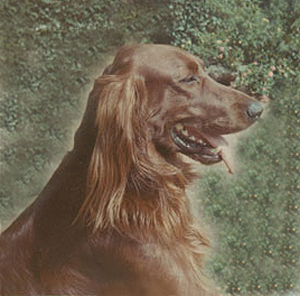
Patches
The runt of the litter my parents gave me at the age
of 12 grew to be a large, handsome, always happy friend who was an
enthusiastic fellow hiker through the hills and canyons of my youth.
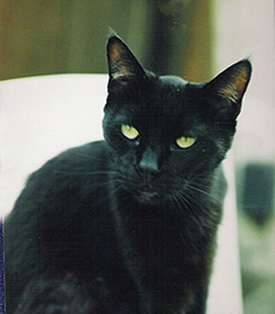
Lunchbucket
A novel could be written about the adventures and
misadventures of this amazing pal of mine who hopped into my car one
day in 1991 and stayed with me for more than 12 years. Lunchbucket
survived the L.A. Riots (she was shot in the back by a BB gun) several
earthquakes, including the big one in '94. What a survivor! One day
in 2003 she disappeared forever and I later learned she found herself
cornered by three coyotes. Two would never have defeated her.
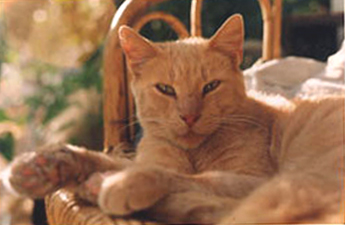
Raspy
I almost stepped on a tiny abandoned kitten while
hiking in Griffith Park so naturally I had to bring Raspy home, for
he hypnotized me with his Rasputin-like stare. I had just acquired
Lunchbucket a couple of weeks before and after some hissing they became
fast friends for years. Raspy was the Huck Finn of cats and very affectionate.
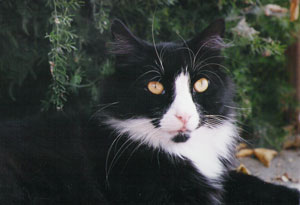
Sylvester
The beautiful mysterious Sylvester just appeared one
day and stayed, I think to keep company with Lunchbucket and Raspy.
My French neighbors became very attached to this photogenic being
and so Sylvester decided to adopt them. Au revoir, mon ami!
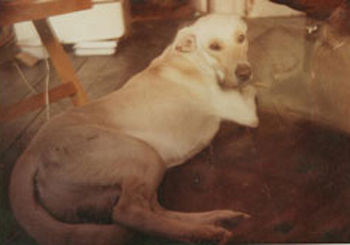
Woodrow Woodstock Wilson
My friend Sheila bought a little puppy for me on my
birthday while we were in Woodstock, NY. Little did I know the pup
would grow to be as big as a small horse! I raised Woodrow as best
I could in the Lower East Side. He saved my life twice from muggers
during late night walks and won a heroic battle against a spike-studded
pitt bull that a Rican gang member sic'd on him. Eventually I took
Woodrow on a glorious tour. We trotted along Georgia beaches, paraded
through the French Quarter, traversed the entire state of Texas and
then visited picturesque villages in Mexico. Unfortunately I had to
leave Woodrow behind on a ranch in Mexico and I hope he realizes I
never wanted to part company with such a wonderful friend. My prayer
is that Woodrow has sired a new breed of cream labs that are populating
the villages and ranches throughout Mexico.
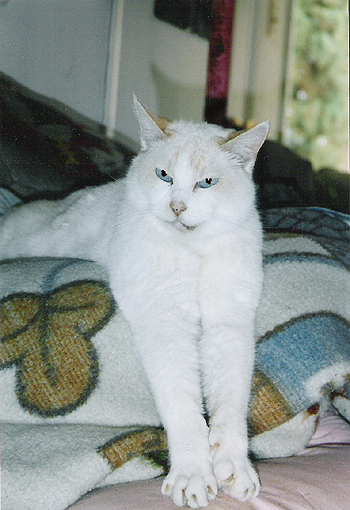
The elegant and regal Snow-Cat, my current owner,
a semi wild feline who befriended Lunchbucket when we moved to a new
home in late 2000. It was interesting seeing an all-black cat friendly
and hanging out with an all-white one. Lunchbucket became a victim
of coyotes in 2003. Three years later I found Snow-Cat lying on the
ground, the victim of a racoon attack, according to the vet to whom
I rushed her. She recuperated at my home and since that time is a
wild thing no longer but a thoroughly domesticated lover of hearth
and home, knowing very few racoons will ever intrude inside a human
dwelling. In October 2008 a young lady of 27-years told me that Snow-Cat
was once known as "Snuggles" a kitten she had gotten when
she was 12. Therefore, Snow-Cat, Snuggles or Snow Ball, another name
given her, was born in 1993 and turned 17 years old in 2010. She shows
no signs of being this old, and indeed often plays like a kitten.

















